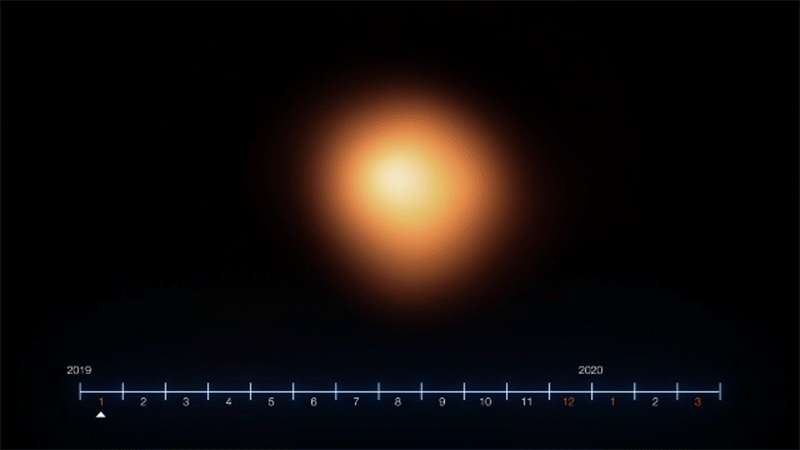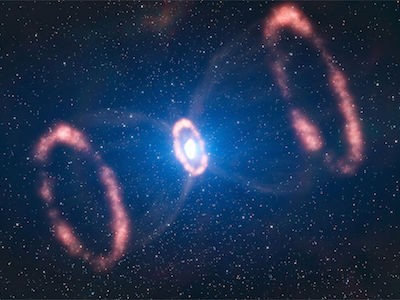Last year’s dramatic dimming of the star Betelgeuse — familiar to many as the ‘right shoulder’ of the constellation Orion — was caused by a cloud of dust spewed out by the star itself. Astrophysicists reached this conclusion, published on 16 June in Nature1, using high-resolution imaging of Betelgeuse before and after the dimming, combined with computer simulations.
Normally, Betelgeuse is one of the ten brightest stars in the night sky. For decades, researchers have known that it undergoes cycles of dimming roughly every 425 days, during which it temporarily loses about one-quarter of its peak brightness. But in February 2020, astronomers noticed that the star’s brightness had dropped by an unprecedented two-thirds — enough to be noticeable with the naked eye.
The unexplained dimming fuelled speculation that the star could be about to explode. Betelgeuse is a red supergiant — a type of star that’s more massive and thousands of times shorter-lived than the Sun — and it is expected to end its life in a spectacular supernova explosion sometime in the next 100,000 years. This event would provide a spectacle the likes of which Earthlings have not seen in centuries: the last supernova in the Milky Way that could be observed from Earth was in 1604, and Betelgeuse is so close to our planet that its supernova will be bright enough to be visible during daytime for weeks. The star is around 168 parsecs (548 light years) away, according to the most current estimates2.
But many astrophysicists warned that the supernova speculation was wishful thinking. They pointed out that the dimming was likely to be caused by more mundane mechanisms, such as a blob of unusually cold matter coming to the surface of the star in what’s known as a convective cell coming to the surface of the star, or a cloud of dust crossing the line of sight to it.
Now, astrophysicist Miguel Montargès at the Paris Observatory and his collaborators have found that the reason for the ‘great dimming’ was probably a combination of both of those factors.
Mystery solved
The team took a series of high-resolution images of the star in January 2019, December 2019, January 2020 and March 2020, using the Very Large Telescope in Chile’s Atacama Desert. Betelgeuse is more than 16 times the mass of the Sun, and 764 times its width — so big that if it were located at the centre of the Solar System, it would engulf the orbits of all the planets up to Mars. This makes it one of the few stars that astronomers can resolve as a disk, rather than as a single dot of light, explains Montargès, who has been studying Betelgeuse on and off for a decade and has been interested in it since he was ten years old, when it was the first star that he was able to identify in the sky.
The images clearly showed that the bottom left-hand part of the star — as seen from Earth's Northern Hemisphere — had dimmed dramatically, and that the position of the darker region did not change substantially over the imaging period. This indicated that the dim spot was caused by a cloud of dust that had been spewed by the star itself, and was moving roughly in the direction of the line of sight, rather than passing by. “If it had been one cloud transiting, it should have crossed the star,” Montargès says.
The team’s explanation for the dimming is that an unusually cool convective cell led to a drastic drop in temperature in the star’s atmosphere. This enabled gas that the star had spewed out in the previous year to condense quickly into dust, blocking out light from the star. This scenario was the one that fit the data best, as the researchers confirmed by running around 10,000 computer simulations. “The conclusion from the modelling is that both events happened at the same time,” says Montargès.
“The fact that a simulation was run makes me more convinced” that the explanation is correct, says Meridith Joyce, an astrophysicist at the Space Telescope Science Institute in Baltimore, Maryland.
“It would be wonderful if we could know in how many days or years Betelgeuse should explode as a supernova,” says astrophysicist Chiaki Kobayashi at the University of Hertfordshire in Hatfield, UK. However, researchers don’t yet have a sufficiently detailed understanding of Betelgeuse — or of red supergiants in general — to be able to make such a prediction.
"last" - Google News
June 16, 2021 at 10:41PM
https://ift.tt/2TAX4j1
Why the supergiant star Betelgeuse went mysteriously dim last year - Nature.com
"last" - Google News
https://ift.tt/2rbmsh7
https://ift.tt/2Wq6qvt
Bagikan Berita Ini


















0 Response to "Why the supergiant star Betelgeuse went mysteriously dim last year - Nature.com"
Post a Comment